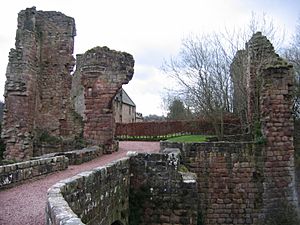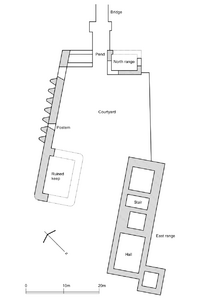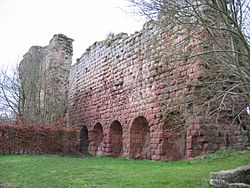Roslin Castle facts for kids
Quick facts for kids Roslin Castle |
|
|---|---|
| Roslin, Scotland Grid Ref. |
|

The approach to Roslin Castle over the bridge, and showing the east range behind the ruined gatehouse.
|
|
| Coordinates | 55°51′09.50″N 3°09′35.50″W / 55.8526389°N 3.1598611°W |
| Site information | |
| Owner | The 7th Earl of Rosslyn |
| Condition | Partially ruined, partially habitable |
| Site history | |
| Built | 14th to 17th centuries |
| Built by | Henry I Sinclair, Earl of Orkney |
| In use | 14th century to present |
| Materials | Stone |
Roslin Castle (sometimes spelled Rosslyn) is an old castle that is partly in ruins. It is located near the village of Roslin in Midlothian, Scotland. The castle is about 9 miles south of Edinburgh. It sits on the north bank of the River North Esk, very close to the famous Rosslyn Chapel.
There has been a castle on this spot since the early 1300s. The Sinclair family, who were Earls of Caithness and Barons of Roslin, built strong defenses here. The parts of the castle you see today were built a bit later. After being badly damaged in a war in 1544, the castle was rebuilt. This new structure, built into the cliffs of Roslin Glen, has been partly lived in ever since. You reach the castle by crossing a high bridge, which replaced an older drawbridge. Roslin Castle was fixed up in the 1980s and is now used as a place for people to stay on holiday.
Contents
History of Roslin Castle
The first castle was built either in the late 1300s or early 1400s. It might have been started by Henry Sinclair, Earl of Orkney (around 1345–1400). The Sinclair family, also known as St Clare, came from France. They have owned Roslin since 1280. The castle was built on a rocky point near where the Battle of Roslin happened in 1303. In that battle, the Scots won against the English.
Henry's son, Henry, 2nd Earl of Orkney (around 1375-1422), built a new, rectangular tower, called a keep. This keep had rounded corners and was at the southwest side of the castle. You entered the castle courtyard by crossing a drawbridge over a man-made ditch. This led to a passage in the small northern part of the castle.
Important Manuscripts
In the 1400s, the castle had a scriptorium, which was a room where books and documents were copied. Five old Sinclair manuscripts, from as far back as 1488, are now kept in the National Library of Scotland. These include the Rosslyn-Hay manuscript, which is thought to be the oldest surviving book written in Scots prose. The castle was damaged by a fire inside the building in 1452. A story says that during this fire, the Earl was worried about his valuable manuscripts. But his chaplain saved them by lowering them out of a window.
Wars and Damage
Roslin Castle was much more seriously damaged in 1544. This happened when the Earl of Hertford burned the castle during a conflict known as the War of the Rough Wooing. The main tower (keep) was almost completely destroyed. You can still see one ruined wall of it today.
The castle was rebuilt in the late 1500s. A new five-story building, called the east range, was built into the side of the rock. The gatehouse was also rebuilt, this time with a strong stone bridge. In 1591, the Laird of Roslin lost his ownership, and the castle was held by William Leslie for the Earl of Huntly. The rebel Earl of Bothwell stayed here once. He left in a hurry, leaving his clothes and silver behind!
The upper part of the east range was updated in 1622. It got new Renaissance-style details and carvings around the doors and windows. Roslin suffered again in 1650 from the cannons of Cromwell’s commander in Scotland, General Monck. It was damaged even more by a group of reformers in 1688. By the 1700s, the castle was falling apart, but part of the east range has always been lived in.
Modern Ownership and Use
James Erskine took over the Rosslyn and Dysart estates in 1789. He then took the name St Clair-Erskine. In 1805, he became the Earl of Rosslyn. Since then, the Rosslyn estate has belonged to the Earl of Rosslyn.
From 1982 to 1988, the east range was carefully restored by architects Simpson and Brown. The current owner, The 7th Earl of Rosslyn, is a descendant of the Sinclair family. He rents out the castle as holiday accommodation through the Landmark Trust. The castle is a Scheduled Ancient Monument, which means it's a very important historical site. It is also a Category A listed building, showing its special architectural importance.
Architecture of Roslin Castle
The castle sits high up on a loop of the River North Esk. This river protects it on three sides. The rocky point where the castle stands was cut on the north side to create a ditch, adding more protection. You get to the castle from Roslin by crossing this ditch on a steep bridge and going through the ruined gatehouse.
Ruined Parts
What's left of the gatehouse and the north part of the castle are just pieces of walls. You can see one side of the entrance arch, with what's left of a small turret (called a bartizan) above it. Along the west side of the castle, the wall built in the 1400s (called a curtain wall) is still quite tall. This part of the wall has six openings at the bottom. One of these was a secret back gate (a postern gate). On the outside, the six sections are separated by rounded supports (called buttresses). Old drawings of Roslin show small turrets above each of these supports, with a walkway connecting them.
To the south of this wall is the remaining wall of the main tower (the keep). The hill underneath is made from the collapsed pieces of the other three walls. The ruins suggest the keep was about 16 meters by 12 meters. Its walls were 2.9 meters thick and rose to a parapet with openings for dropping things on attackers (called a machicolated parapet).
The East Range
The restored east range is about 31 meters long and 10 meters wide. It has a sloped roof and stepped gables. You enter it through a beautifully carved doorway, which is dated 1622. It has the initials SWS for Sir William Sinclair. This doorway leads to the third floor. The three floors below are carved into the rock. Each of these floors has four rooms with arched ceilings. There is a fifth room in the southeast tower. These lower levels were used for service rooms, like a kitchen on the lowest floor and a bakehouse above it. The main rooms were on the two upper floors. On the outside, you can see openings for guns on the south wall, and several small holes for shooting on the east side.
All five floors are connected by a central staircase that was added in the early 1600s. It replaced an older spiral staircase in the southwest. The rooms on the upper floors have impressive wooden panels and decorated ceilings. The main hall, in the southern part of the building, has been divided. But it still has a large fireplace with the carved initials WS and JE, for William Sinclair and his wife Jean Edmonstone, and the date 1597.
Roslin Castle in Popular Culture
Roslin Castle is mentioned in Sir Walter Scott's poem Rosabelle. An old song called Roslin Castle was written in the 1700s by Richard Hewitt. The words and music for this song are in the Scots Musical Museum collection of Scottish songs.
The castle was also used as a filming location for Ron Howard's movie The Da Vinci Code. This movie was based on the popular book by Dan Brown. The castle also appears in the book The Scottish Chiefs.
See also
 In Spanish: Castillo de Roslin para niños
In Spanish: Castillo de Roslin para niños







